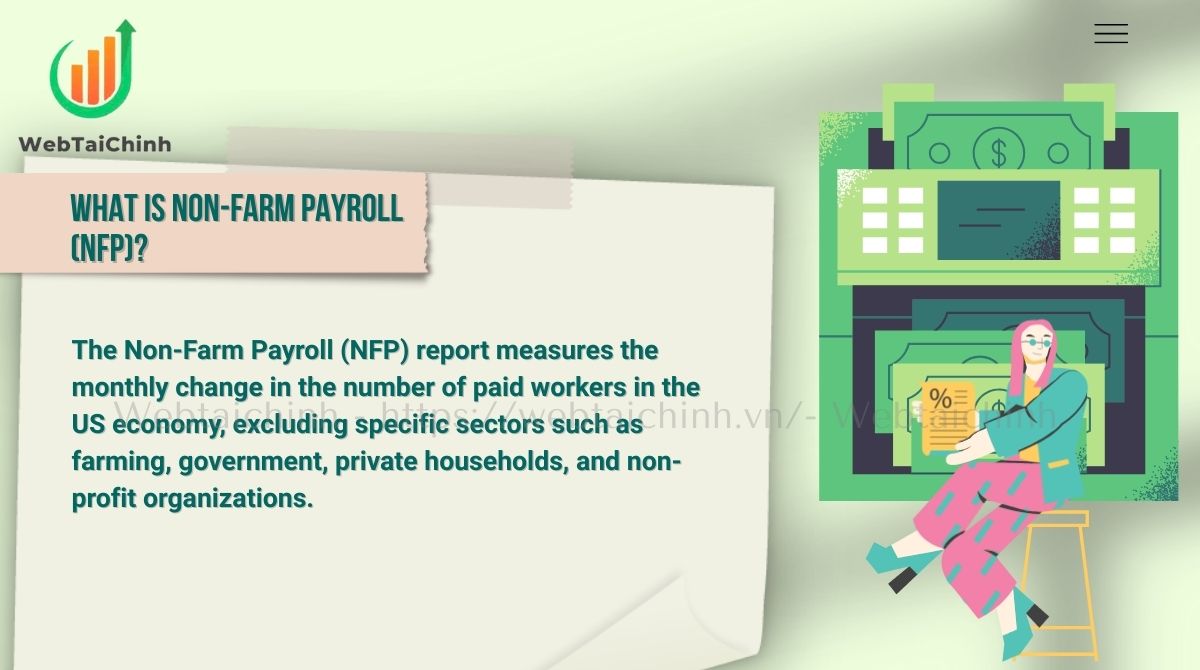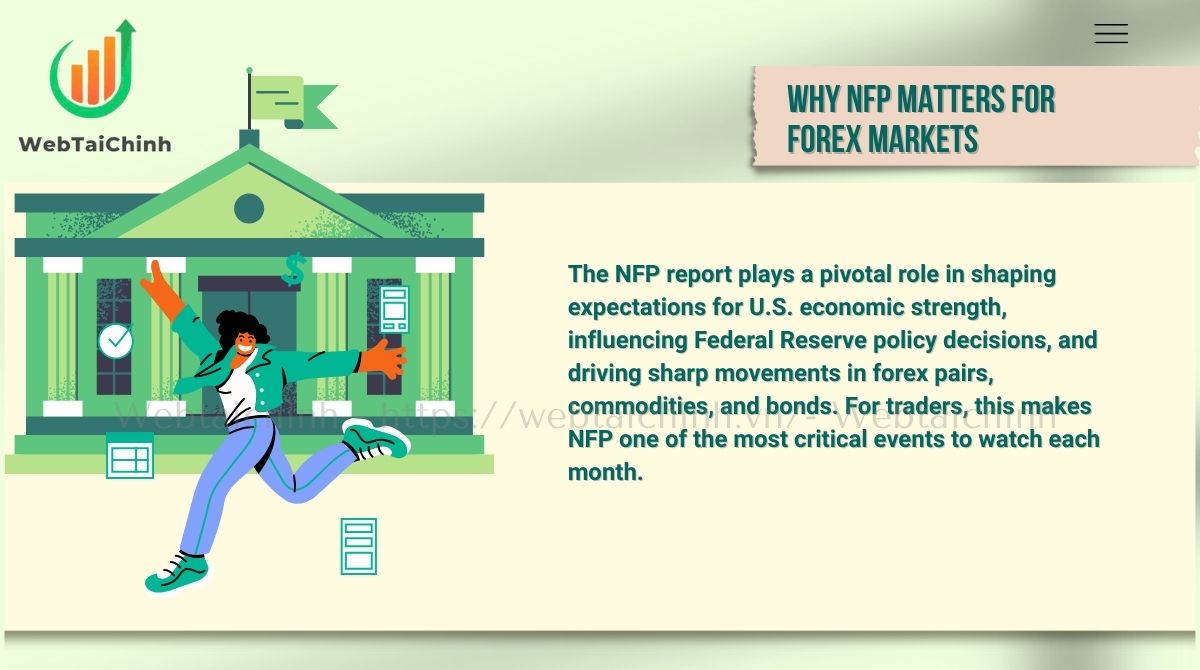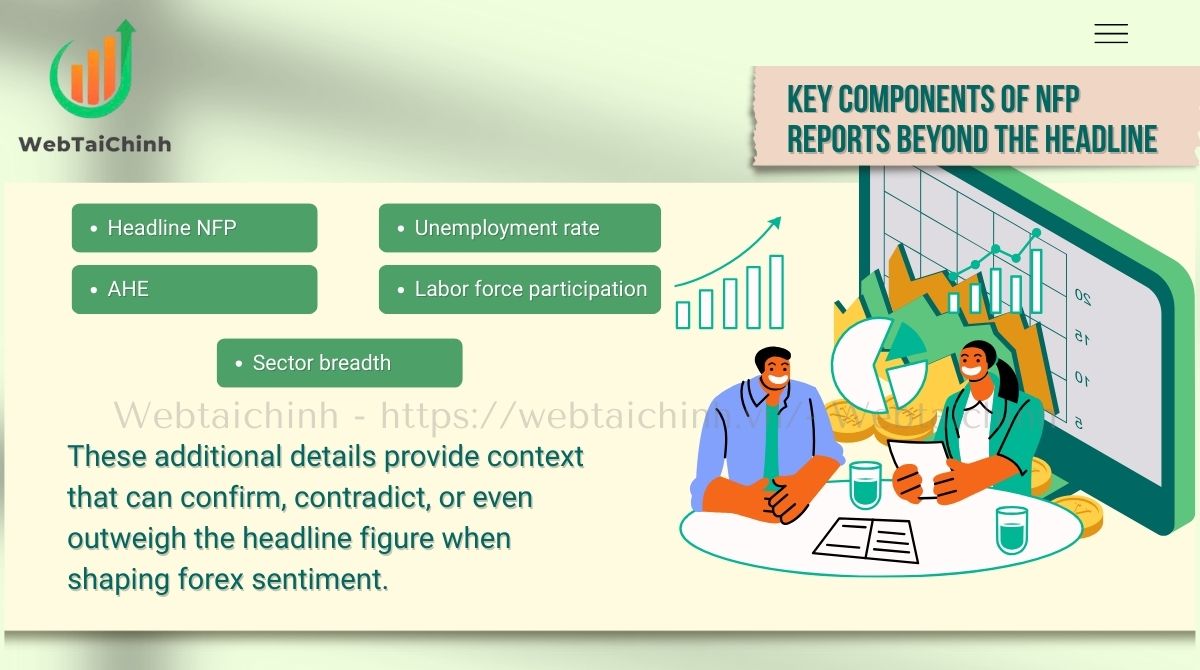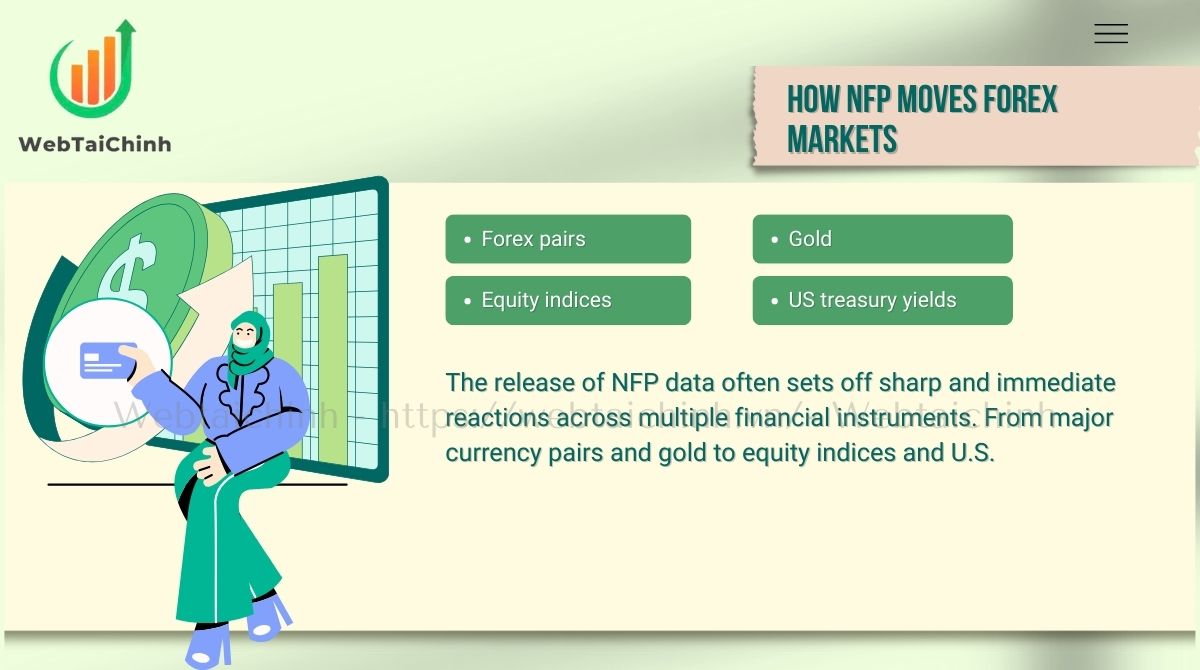Physical Address
304 North Cardinal St.
Dorchester Center, MA 02124
Physical Address
304 North Cardinal St.
Dorchester Center, MA 02124

In forex trading, few economic events generate as much anticipation and market volatility as the Non-Farm Payroll report. Understanding what is non farm payroll in forex is essential for traders who want to interpret labor market data and predict USD-driven price swings.
The NFP is more than just a jobs number; it is a powerful indicator of U.S. economic health, Federal Reserve policy direction, and global market sentiment. This guide breaks down its definition, release schedule, impact on currency pairs, and strategies to trade NFP events effectively.
Key takeaways:
The Non-Farm Payroll (NFP) report measures the monthly change in the number of paid workers in the US economy, excluding specific sectors such as farming, government, private households, and non-profit organizations. These exclusions are made because farm employment is seasonal and volatile, government jobs have different hiring dynamics, and private household work is irregular, making them less reflective of broader economic trends.

According to the U.S. Bureau of Labor Statistics (BLS), the NFP covers approximately 80% of total US employment, representing key industries like manufacturing, construction, retail trade, transportation, and financial services. This coverage makes NFP a reliable gauge of labor market health and economic momentum.
Definition box:
Non-Farm Payroll (NFP) = Monthly change in paid US workers excluding farm sector, government, private households, and nonprofits.
It is important to distinguish NFP headline numbers from the broader Employment Situation report, which also includes the unemployment rate, labor force participation, and wage data. While NFP focuses on job growth, the accompanying data provide a fuller picture of labor market conditions.
To fully understand what is Non Farm Payroll in forex, traders need to know who publishes the data, when it becomes available, and where it can be accessed. The NFP report is compiled and released by a trusted U.S. agency, following a strict monthly schedule.
Its revisions and updates often trigger significant forex market volatility, making this knowledge crucial for anyone looking to interpret NFP effectively and trade with confidence.
The NFP report is published by the U.S. Bureau of Labor Statistics (BLS), a reputable and government-funded agency responsible for compiling key economic data. The BLS’s role ensures that the NFP data is credible, transparent, and consistent over time, making it a cornerstone for economic analysis and financial market decision-making.
NFP data are released monthly, typically on the first Friday of the month at 8:30 AM Eastern Time. The report reflects employment changes for the previous month, hence a reporting lag of several weeks. This lag allows the BLS sufficient time to collect and verify extensive payroll data from thousands of businesses across the US.
Initial NFP numbers are often revised in subsequent releases based on updated or corrected data. Revisions may be upward or downward and can cause notable forex market reactions since traders adjust their outlooks accordingly.
| Aspect | Details |
| Publisher | U.S. Bureau of Labor Statistics (BLS) |
| Release cadence | Monthly, first Friday |
| Release time (ET) | 08:30 AM |
| Data period | Previous month |
| Typical revision impact | ±10K to ±50K jobs; can cause USD volatility |
Understanding what is Non Farm Payroll in forex is not only about knowing its definition but also about recognizing its impact on global financial markets. The NFP report plays a pivotal role in shaping expectations for U.S. economic strength, influencing Federal Reserve policy decisions, and driving sharp movements in forex pairs, commodities, and bonds. For traders, this makes NFP one of the most critical events to watch each month.

NFP is a critical barometer of US economic health and labor market demand. Because employment growth signals expanding business activity and consumer spending potential, NFP data feed directly into market expectations for Federal Reserve interest rate policies and inflation trends.
Fed policy sensitivity: Strong NFP numbers often increase expectations that the Fed will maintain or raise interest rates to curb inflation, boosting the USD. Conversely, disappointing data can spur rate cut speculation.
Market ripple effects: USD pairs such as EUR/USD, USD/JPY, and GBP/USD show heightened volatility on NFP days. Risk assets like stocks and commodities, especially gold and Treasury yields, also react sharply, given the intertwined nature of global capital flows and inflation expectations.
Due to these dynamics, forex volatility surges during NFP releases as traders swiftly reposition portfolios based on updated economic signals.
Consensus forecasts for NFP are aggregated from polls by Bloomberg, Reuters, and other financial news agencies, encapsulating analyst expectations into a median number traders use as a baseline.
Market reactions depend heavily on how actual data compares to these forecasts:
Exceptions occur when strong jobs growth coincides with weak wage gains or rising unemployment, leading to mixed interpretations. In some scenarios, “good news is bad news” if robust employment stokes fears of aggressive Fed tightening that could hamper growth further.
| Scenario | Market reaction | USD movement |
| Big beat (+100K+ jobs) | USD strengthens, risk appetite moderates | USD up |
| Small miss (less than forecast) | Subtle USD weakness or neutral | USD flat/slightly down |
| Large miss or eegative | USD sells off, risk sentiment worry | USD down |
Real-world examples include the March 2025 NFP release, which surprised with +600K jobs, sending EUR/USD sharply below 1.08, and a disappointing January 2025 report causing USD weakness despite strong wage data.
The headline number in an NFP release often grabs the spotlight, but it is only part of the story. To truly understand labor market conditions and predict market reactions, traders must also pay attention to supporting metrics like unemployment, wage growth, labor force participation, and sector-specific performance. These additional details provide context that can confirm, contradict, or even outweigh the headline figure when shaping forex sentiment.

| Metric | What it means | Why traders watch |
| Headline NFP | Total change in payroll jobs | Direct indicator of labor demand and economic growth |
| Unemployment rate | Percentage of unemployed looking for work | Shows labor market slack; can confirm or contradict NFP |
| Average hourly earnings (AHE) | Change in wages | Signals wage inflation pressures; influences Fed inflation outlook |
| Labor force participation | Percentage of working-age population employed or seeking work | Helps interpret strength of employment trends |
| Sector breadth | Jobs added/lost by industry | Highlights where growth or weakness is concentrated |
For example, in November 2024, despite a modestly positive jobs number, rising unemployment and flat wages led to USD weakness, showing why traders must analyze these metrics collectively rather than headline NFP alone. Additionally, the household survey (used for unemployment rate) often moves differently from the establishment survey (NFP jobs), and this divergence can sway market sentiment.
The release of NFP data often sets off sharp and immediate reactions across multiple financial instruments. From major currency pairs and gold to equity indices and U.S. Treasury yields, each market responds differently in both scale and duration. Understanding these typical patterns helps traders anticipate where volatility will emerge and how long its influence is likely to last.

| Instrument | Typical effect | Volatility duration |
| EUR/USD | High volatility, rapid directional moves | 1-3 hours post-release |
| Gold | Inverse USD correlation; quick spikes | 1-2 hours |
| S&P 500 futures | Volatility linked to growth outlook | Several hours |
| US 10Y treasury yields | Move on rate expectations | Several hours to days |
Volatility often peaks within the first 30 minutes after the release but can influence market direction for the rest of the day, especially if accompanied by Fed commentary or unexpected revisions.
Trading around NFP announcements can be highly rewarding but also extremely risky. The sharp volatility creates opportunities for breakout moves and quick profits, yet it also exposes traders to slippage, whipsaws, and psychological traps. By understanding common trading setups and being aware of potential pitfalls, traders can approach NFP days with a structured plan and stronger risk control.
Risks and challenges include slippage, widened spreads, rapid whipsaws, and low liquidity leading to potential losses. Psychological pitfalls are common, such as FOMO (fear of missing out), impulsive overtrading, and ignoring potential data revisions that can alter market dynamics.
| Risk factor | Description |
| Slippage | Order executions at unfavorable prices due to volatility |
| Spread widening | Higher trading costs when bid-ask spreads increase |
| Whipsaws | Rapid price reversals trapping traders |
| Liquidity drops | Lower market depth can cause erratic moves |
Best practices: Use strict risk management, keep position sizes small, avoid chasing trades, and have a clear event-day checklist. Journaling trades for review is essential for mastering NFP setups.
Reacting to NFP data requires more than just watching the headline number; it demands a methodical approach. From setting expectations before the release to analyzing the first market reactions and monitoring follow-up revisions, professional traders rely on a structured process. This discipline helps filter out noise, avoid emotional mistakes, and uncover clearer trading opportunities.
Following this stepwise approach helps traders sidestep emotional errors and position more rationally for sustained trends after NFP.
EUR/USD, USD/JPY, GBP/USD, and USD/CAD experience the largest volatility due to their liquidity and USD involvement.
Typical EUR/USD moves range from 50 to 150 pips within the first hour post-release.
Yes, initial spikes often reverse as traders digest the full report and accompanying wage/unemployment data.
Slight seasonal trends exist, such as slower job growth in winter months, but surprises can occur any month.
Forecasts can deviate by ±50K jobs, with unexpected economic shocks causing larger errors.
Revisions, typically released in subsequent months, can confirm or challenge initial market assumptions leading to additional volatility.
Grasping what is non farm payroll in forex provides traders with a competitive edge in navigating market volatility, especially on NFP release days. From its role in shaping Federal Reserve policies to influencing major currency pairs, the NFP remains one of the most impactful economic indicators in forex.
By combining careful analysis with disciplined risk management, traders can turn NFP volatility into opportunity. For more in-depth insights and strategies, visit webtaichinh — your trusted source for Forex Education.
Web Tai Chinh is a portal that updates news and information related to finance quickly and accurately, helping users have an overview before investing, clearly understanding concepts and terms related to Finance. Explore more insights in our Forex category, start your FX trading journey today with the right partner for long-term success.
📞 Contact: 055 937 9204
✉️ Email: webtaichinhvnvn@gmail.com
📍 Address: 13 Ho Tung Mau, An Binh, Di An, Binh Duong